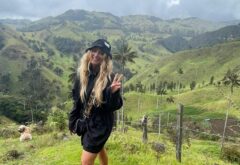The island that dances to its own tune

Our guide Alexander led us down a lush mountain trail en route to an alfresco dip in a freshwater pool, and suddenly stopped. Motioning for us all to stand still, he gently started to whistle.
Within seconds, the trees were filled with birds of all shapes and sizes: tiny bullfinches, warblers, woodpeckers, an emerald-green hummingbird and the Cuban national bird, the green, white and red Trogon.
That walk in Cuba's southern Topes de Collantes National Park, near Trinidad, was one of many unexpected highlights on our trip to this country on the brink of change.
For 50 years, while the rest of the Caribbean was marketing its sun, sea and sand holidays, Fidel Castro and his revolutionaries ensured Cuba was sealed in a time warp, cut off from the capitalist world.
With the collapse of the USSR, Castro's communist comrade-in-arms and main trading partner, Cuba’s economy plunged into turmoil. Cuba opened the floodgates to global tourism (although Americans are not yet permitted to travel there by their own government), and its satin-smooth beaches, rum cocktails and salsa were reinvented for the package tourist market. Yet, as we were to discover, the Caribbean's largest island has much more to offer.
Our first stop was Baracoa, on Cuba's south-eastern tip, where we stayed at El Castillo, located in the remains of an old Spanish fort high on the hillside. Baracoa has an easy, small-town charm, complete with crumbling revolutionary murals celebrating 50 years of Castro's rule. But it's the awe-inspiring countryside that is the star of the show.
For the more adventurous, there is trekking in the local rainforest or the dramatic climb up El Yunque, the 1,900 ft flat-topped mountain that dominates the landscape, but simply enjoying a leisurely river cruise is equally rewarding.
With the average wage being the equivalent of about £12.60 a month, ordinary Cubans earn extra money by renting out rooms (casas particulares) and open restaurants (paladares) in their homes. These are a great opportunity to see how Cubans live, and in Baracoa’s paladares we found some of the best food on the island.
Music and dancing play a huge part in Cuban culture, nowhere more so than in the island's second city – and our second stop – Santiago de Cuba. Around every corner there seems to be a band striking up or a couple swaying to the salsa beat. The city's famous Casa de Trova hosts nightly live music sessions that are not to be missed.
Elsewhere in Santiago, you can get a feel for the Spanish history of the island at the magnificent 17th-century fort of El Morro where they fire the cannon at 5pm every day to recreate the ancient warning to pirates. And the Moncada barracks still display the gunshot marks where Castro and his rebels fired the opening rounds of the revolution in 1953.
With its location so close to both beach and mountains, the perfectly preserved, UNESCO World Heritage site of Trinidad on the south coast is the star of central Cuba. It is also an excellent base from which to explore the attractions of this area, and for those with limited time, it provides an excellent introduction to Cuba.
The colonial district of Trinidad, with its postcard-perfect mansions, cobbled streets and horse-drawn carts, has the feel of a village rather than a prosperous town.
A day trip from Trinidad or a stopover in its own right, Cienfuegos was founded by French settlers. With its stylish houses, bay-side location and spacious squares, it deserves its title 'Pearl of the South'.
We also fitted in a visit to Santa Clara, the city adopted by the students’ poster-boy, Ernesto 'Che' Guevara. He was the principled doctor-turned-guerrilla who fought alongside Castro in the Fifties and was shot by the Bolivian army in 1967. His victory at the battle of Santa Clara earned him god-like status among its residents, and they pay tribute to him at a museum commemorating his life.
What Che would make of Cuba today is anyone's guess. But the word is that this is a country to visit now – before the Americans arrive.
Tailor-made holidays
Flexible, custom-made holidays to Latin America created to match your exact requirements: our tailor-made itineraries are as unique as the clients for whom they are designed.
Design my tripPapagaio
Your edit for Latin American inspiration
Our exciting range of articles on Latin America explore everything from iconic destinations and lesser-known cultural gems to delicious traditional recipes. You’ll also find exclusive travel tips, first-hand client reviews and the chance to get your personal questions answered by our travel experts.
View Extraordinary Inspiration






































